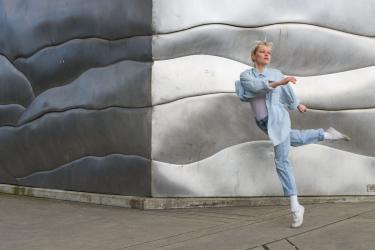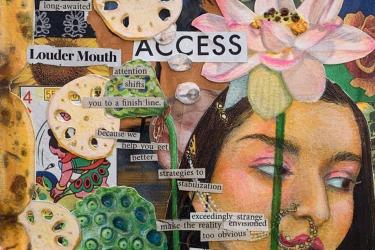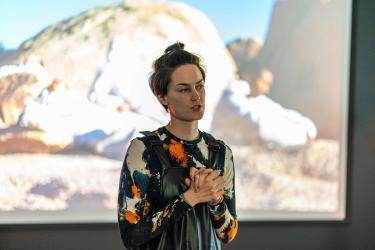AICAD/NOAA Fisheries Art and Science Fellowship
A partnership between the Association of Independent Colleges of Art & Design (AICAD) and NOAA Fisheries embeds artists in the agency to bridge communities and spark innovation
Engaging the public in complex, and sometimes controversial, marine science and policy is one of the hardest things we do. With subjects such as “fish passage barriers,” “salmon reintroduction,” and “nearshore habitat protection,” it’s easy to see why it’s hard for the public to understand how our work connects to their daily lives. Art is uniquely suited to help envision the challenges facing our waterways, the species living in them, and the people whose livelihoods depend on both.
The AICAD/NOAA Fisheries Art + Science Fellowship aims to bridge this gap. This Fellowship pairs artists and designers with NOAA Fisheries policy makers, scientists, and stakeholder communities. These artists-in-residence design works that inspire behavior change to conserve and protect NOAA trust resources. The Fellowship employs artistic practice to communicate scientific and environmental concepts, engender stewardship behavior, connect communities, and spark innovative solutions.
For more information, please visit information about the fellowship on the AICAD website.
2023 Fellowship
Engaging Overlooked Communities | Catherine Ross
The 2023 Art + Science Fellow, Catherine Ross, is a researcher, creative technologist, and sound artist who develops immersive experiences to challenge systemic injustice and raise awareness around environmental issues. Their work finds form in virtual and augmented reality, spatialized sound design, 3D environmental design and animation, data visualization, and live performance.
The 2023 Fellowship focuses on imagining ways to identify and engage recreational and subsistence fishing communities affected by federal fisheries management. The work seeks to engage sometimes-overlooked communities in the decision-making process, and help the agency allocate its services in equitable ways. That goal aligns with a national Equity and Environmental Justice Strategy (PDF, 41 pages) that NOAA Fisheries adopted earlier this year.
Catherine will complete a 6-week residency with NOAA Fisheries during summer 2023, and then will research, produce, and distribute creative work through February 2024.
2022 Fellowship
Recovering California’s Salmon Species | Mickey Morgan
The 2022 Art + Science Fellow, Mickey L.D. Morgan, is a visual and community practice artist and a care worker. They are passionate about neighborliness, believing that every human and non-human part of an ecosystem are essential to all of our lives, which has been a strong theme in their work over the past three years.
The 2022 Fellowship focused on work with NOAA Fisheries West Coast Region’s California Coastal Office to connect with communities to support recovery of seven listed salmon species native to the coast of California: California Coastal Chinook, Southern Oregon Northern California Coast Coho Salmon, Central California Coast Coho Salmon, Southern California Steelhead, South Central California Steelhead, Central California Coast Steelhead, and Northern California Steelhead.
Morgan completed a 6-week residency with NOAA Fisheries during the summer of 2022, followed by an off-site period through February 2023 to research, produce, and distribute creative work.
2021 Fellowship
Puget Sound Nearshore Habitat | Isabel Beavers
The 2021 AICAD/NOAA Art + Science Fellow, Isabel Beavers, is a transdisciplinary artist and creative producer based in Los Angeles. She creates installations, public art, and digital experiences that explore the climate crisis, technology, and ecological justice.
The 2021 Fellowship focused on working with communities in Puget Sound to conserve nearshore habitat crucial to recovering salmon and killer whales. The health of nearshore habitat depends upon the land-management decisions of individual landowners across Puget Sound. Isabel worked with NOAA Fisheries to deepen connections and collaboration with landowners through artistic and cultural strategies, helping shape restoration efforts and accelerate recovery.
2020 Fellowship
Central Valley Salmon Culture | Stephanie Littlebird Fogel
The 2020 Fellowship focused on working with communities to return salmon populations to blocked river habitats in California’s Central Valley. Sacramento River winter-run Chinook have been identified as a species most at risk of extinction in the near future, and reintroduction past Shasta Dam is the single most important action identified in the recovery plan, yet community and stakeholder resistance at multiple levels has hindered the plan for fish passage.
The 2020 NOAA Fisheries/AICAD Fellow, Stephanie Fogel, spent time virtually with scientists, natural resource managers, and community members in California’s Central Valley to research and implement creative strategies to this environmental and cultural dilemma.
Stephanie created a series of watershed-specific “Salmon Country” Signs. Each sign features the body of a salmon with the landscape of their ancestral spawning waters. They created signs for the Yuba River, the Sacramento, Merced, and McCloud, each showing the unique physical characteristics of that specific river.
She worked with NOAA scientists to improve the absorption of scientific information by enhancing existing scientific diagrams, such as the powerpoint slide below.





